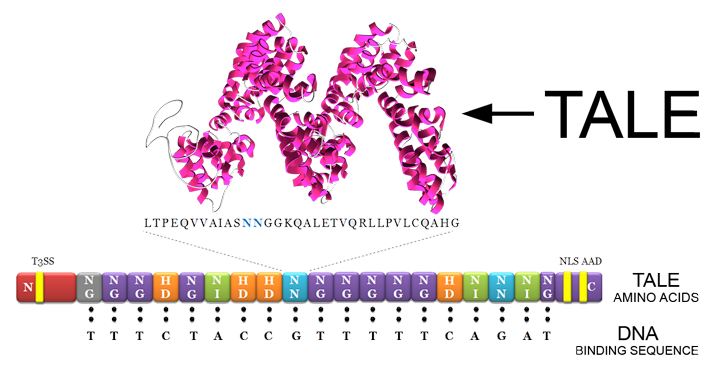Difference between revisions of "Part:BBa K1189006"
Iaingeorge (Talk | contribs) |
|||
| Line 3: | Line 3: | ||
Using the target sequences created for both TALEA (BBa_K782004) and TALEB (BBa_K782006), we assembled this target sequence construct to be used in our proof of concept system. Because TALEB was discovered to have a mutation, we have two versions of this construct. One has the original TALE B target sequence we created assuming there was no mutation. This is the new target sequence. | Using the target sequences created for both TALEA (BBa_K782004) and TALEB (BBa_K782006), we assembled this target sequence construct to be used in our proof of concept system. Because TALEB was discovered to have a mutation, we have two versions of this construct. One has the original TALE B target sequence we created assuming there was no mutation. This is the new target sequence. | ||
| + | |||
| + | <html> | ||
| + | <figure> | ||
| + | <img src="https://static.igem.org/mediawiki/2013/5/54/TALE_B_and_TALE_A_B-lac_DNA_capture_assay.png" alt="TALE DNA Capture Assay" width="800" height="600"> | ||
| + | <figcaption> | ||
| + | <p><b>Figure 6: </b> TALE capture assay was done with TALE B (<a href="https://parts.igem.org/wiki/index.php?title=Part:BBa_K1189001"> | ||
| + | <span class="Green"><b> | ||
| + | BBa_K1189001 | ||
| + | </b></span> | ||
| + | </a >)and TALE A B-lac fusion (<a href=" https://parts.igem.org/wiki/index.php?title=Part:BBa_K1189031"> | ||
| + | <span class="Green"><b> | ||
| + | BBa_K1189031 | ||
| + | </b></span> | ||
| + | </a >) and DNA (<a href="https://parts.igem.org/wiki/index.php?title=Part:BBa_K1189006"> | ||
| + | <span class="Green"><b> | ||
| + | BBa_K1189006 | ||
| + | </b></span> </a >) | ||
| + | with both target sequences. If capture is successful, the B-lac is present in the well giving a colour change from pink to yellow when subjected to benzylpenicillin substrate solution within 20 minutes. The only wells that change colour are the first four wells which contain TALE B, specific DNA, and TALE A B-lac fusion and our positive control wells which are the controls for our fusion TALE A B-lac protein and our positive recombinant b-lac. All our other controls including our test using a non-specific sequence of DNA remained pink . This preliminary characterization data demonstrates that the TALEs are able to bind to DNA with specificity. Additionally it also shows that our system of capturing DNA with two detector TALEs and then subsequent reporting of the DNA’s presence works. | ||
| + | </figcaption> | ||
| + | </figure> | ||
| + | |||
| + | <p>This assay shows that we can <b> capture our target DNA </b> with two detector TALEs with <b>specificity </b>. Additionally, <b> we can report whether that DNA has been captured</b> and is present in the sample, which is a very important concept for our sensor system. </p> </html> | ||
[[File:Calgary2013-TALE-RVD.png]] | [[File:Calgary2013-TALE-RVD.png]] | ||
Revision as of 02:13, 5 October 2013
TALEA and TALEB Target
Using the target sequences created for both TALEA (BBa_K782004) and TALEB (BBa_K782006), we assembled this target sequence construct to be used in our proof of concept system. Because TALEB was discovered to have a mutation, we have two versions of this construct. One has the original TALE B target sequence we created assuming there was no mutation. This is the new target sequence.
Figure 6: TALE capture assay was done with TALE B (
BBa_K1189001
)and TALE A B-lac fusion (
BBa_K1189031
) and DNA (
BBa_K1189006
)
with both target sequences. If capture is successful, the B-lac is present in the well giving a colour change from pink to yellow when subjected to benzylpenicillin substrate solution within 20 minutes. The only wells that change colour are the first four wells which contain TALE B, specific DNA, and TALE A B-lac fusion and our positive control wells which are the controls for our fusion TALE A B-lac protein and our positive recombinant b-lac. All our other controls including our test using a non-specific sequence of DNA remained pink . This preliminary characterization data demonstrates that the TALEs are able to bind to DNA with specificity. Additionally it also shows that our system of capturing DNA with two detector TALEs and then subsequent reporting of the DNA’s presence works.

This assay shows that we can capture our target DNA with two detector TALEs with specificity . Additionally, we can report whether that DNA has been captured and is present in the sample, which is a very important concept for our sensor system.
Sequence and Features
- 10COMPATIBLE WITH RFC[10]
- 12COMPATIBLE WITH RFC[12]
- 21COMPATIBLE WITH RFC[21]
- 23COMPATIBLE WITH RFC[23]
- 25INCOMPATIBLE WITH RFC[25]Illegal AgeI site found at 213
- 1000COMPATIBLE WITH RFC[1000]

